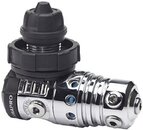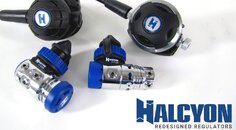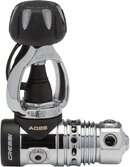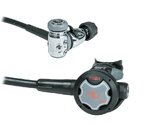That's correct and one should not base an opinion on rental scuba equipment. Not only they are entry level regs that have been abused but many dive stores set the regs so they don't free flow easily sacrificing breathing effort at shallow depths.Of course not.
Diaphragm, piston, sealed/non sealed etc etc.
All rental equipment that I used occasionally are all at the lower end of the spectrum.
You are using an out of date browser. It may not display this or other websites correctly.
You should upgrade or use an alternative browser.
You should upgrade or use an alternative browser.
Atomic users
- Thread starter Tracerbullet
- Start date
Please register or login
Welcome to ScubaBoard, the world's largest scuba diving community. Registration is not required to read the forums, but we encourage you to join. Joining has its benefits and enables you to participate in the discussions.
Benefits of registering include
- Ability to post and comment on topics and discussions.
- A Free photo gallery to share your dive photos with the world.
- You can make this box go away
Atomic has basically remained unchanged since 1996. So has your - amazing - Mk 25 / S600 combo.I thought that to be the case about old vs new Atomics, but didn't want to say so for fear someone would correct me aggressively. I was told years ago that the two guys who originally started Atomic copied their design from ScubaPro where they worked. True? False?
My 20 year old ScubaPro reg is a MK25 with S600 second. I don't think there is much that really counts that is different today.
I am eyeballing the Black Tech version but I will never sell my 2012 original one...
Is it me OR Scubapro 2nd stages are getting uglier?
I would caution that with the Atomics, soaking pressurized is a very good idea. When off the cylinder, the second stage seat saver orifice can work against you. Without the cylinder pressure, the 2nd is no longer sealed, so water could travel down the lines into the 1st. Keeping the 1st above the second will work, but soaking pressurized is easier, and not a bad idea for any reg.
Yep, the lube adds cost that is really not necessary as there are better solutions.
Sealed diaphragms definitely make things easier, especially if diving in saltwater. I’ve got 3 sealed diaphragms in the family kit. The oldest is just under 20 years old. The 1sts get rinsed, the seconds get soaked pressurized, and at service time, it is rare that the tech doesn’t remark on the cleanliness.
All regs should be soaked when pressurized ideally.
I've seen folks dumping their regs on plastic tubs because they had the 'cap on' (lol) and/or the first stage had an auto sealing valve or ball bearing to keep water out...
If I have to rinse my first satge w/o being pressurized, I seal the DIN valve with my thumb and try not to get water nowhere near the upper threads just in case
Regarding sealed diaphragms vs non-sealled pistons, I dive both and never had any issue with salt corrosion. One thing is clear, piston regs have better airflow no matter what.
Keeping pace with Halcyon...Is it me OR Scubapro 2nd stages are getting uglier?
Halcyon are also ugly indeed and they are rebadging the Mk 17 / Mk 25 as well as Cressi (Mk 25) or TUSA (Mk 11 and Mk 17)Keeping pace with Halcyon...
All licensed I guess...
Attachments
Mk17 should save quite a bit but soon to be discontinued(more discount?).
Belzelbub
Contributor
I agree completely. However, there are many divers (here and elsewhere) that don't do this. I'd imagine the majority of the rental fleet never gets soaked pressurized. Some dust caps are just that. Others do a bit better and actually are somewhat water resistant. I wouldn't take them to depth this way, but might be OK in a tub.All regs should be soaked when pressurized ideally.
The Atomic seat saver feature makes this more important, as water can get past the 2nd stage. It will probably take a bit to get all the way into the 1st, so it's not the end of the world in most cases. Still, much better to pressurize when soaking. If that's not possible, keeping the 1st above the 2nds should keep water from getting in.
True, but it's really in an area where it's pretty much moot in the real world. Both pistons and diaphragms are capable of delivering significantly more air than could be used by a diver, or divers in an airsharing situation.Regarding sealed diaphragms vs non-sealled pistons, I dive both and never had any issue with salt corrosion. One thing is clear, piston regs have better airflow no matter what.
"Ideally"!All regs should be soaked when pressurized ideally.
Regarding sealed diaphragms vs non-sealled pistons, I dive both and never had any issue with salt corrosion. One thing is clear, piston regs have better airflow no matter what.
Not practical in any dive boat(day or liveaboard) that I have been.
I always carry a bottle of fresh water and pout over the 1st stage before changing tank. Some of the dive boat might have shower hose long enough to reach is much better.
Better airflow only exists on paper, no practical meaning whatsoever.
Scubapro Mk25: flow rate at 200 bar is >8500L/min.
My usual SAC is around 6-10L/min
I agree completely. However, there are many divers (here and elsewhere) that don't do this. I'd imagine the majority of the rental fleet never gets soaked pressurized. Some dust caps are just that. Others do a bit better and actually are somewhat water resistant. I wouldn't take them to depth this way, but might be OK in a tub.
The Atomic seat saver feature makes this more important, as water can get past the 2nd stage. It will probably take a bit to get all the way into the 1st, so it's not the end of the world in most cases. Still, much better to pressurize when soaking. If that's not possible, keeping the 1st above the 2nds should keep water from getting in.
True, but it's really in an area where it's pretty much moot in the real world. Both pistons and diaphragms are capable of delivering significantly more air than could be used by a diver, or divers in an airsharing situation.
Aboslutely, I dive an Mk17 and Mk25 and can attest to that. I bought the Mk17 for travelling but it is actually heavier than the Mk 25. Diaphragm regs are heavier than piston ones (less moving parts).
However, I do feel a little difference when switching between the 2 (my 2ns stage on the Mk 25 is an S600 while on the Mk 17 a non-balanced R 395 so that might play a part as well at least at depth). This is an old video from Scubapro, their engineer seems to favor the Mk25, what's more interesting for me is the bore of the air channel within the piston vs the Mk 17. Very interesting.
I totally agree on the first part, will disagree on the 2nd."Ideally"!
Not practical in any dive boat(day or liveaboard) that I have been.
I always carry a bottle of fresh water and pout over the 1st stage before changing tank. Some of the dive boat might have shower hose long enough to reach is much better.
Better airflow only exists on paper, no practical meaning whatsoever.
Scubapro Mk25: flow rate at 200 bar is >8500L/min.
My usual SAC is around 6-10L/min
The difference is small but there is a difference between a piston and a diaphragm regulator nevertheless. If you get the chance to compare them on the same dive you will feel it as well. The flow rate indication vs your sac is a nice indicator if you are relaxed. Whatever issues one can have will appear under stress and at depth, like in an OOA situation were the buddy breathes erratically and in panic.
The Mk25 has indeed 8.500 l/min while the Mk 17 has 6900 l/min. That's quite a 'theoretical' difference there. Just mind that if there were no differences, we would all be diving the venerable Mk 2 and its 2.600 l/min flow rate
There are also other factors that make a reg better than other like inhalation / cracking effort, if it breathes wet, etc... as well as the 2nd stage performance (negligible but its also there).
Similar threads
- Replies
- 21
- Views
- 2,731
- Replies
- 33
- Views
- 4,673
- Replies
- 3
- Views
- 677







